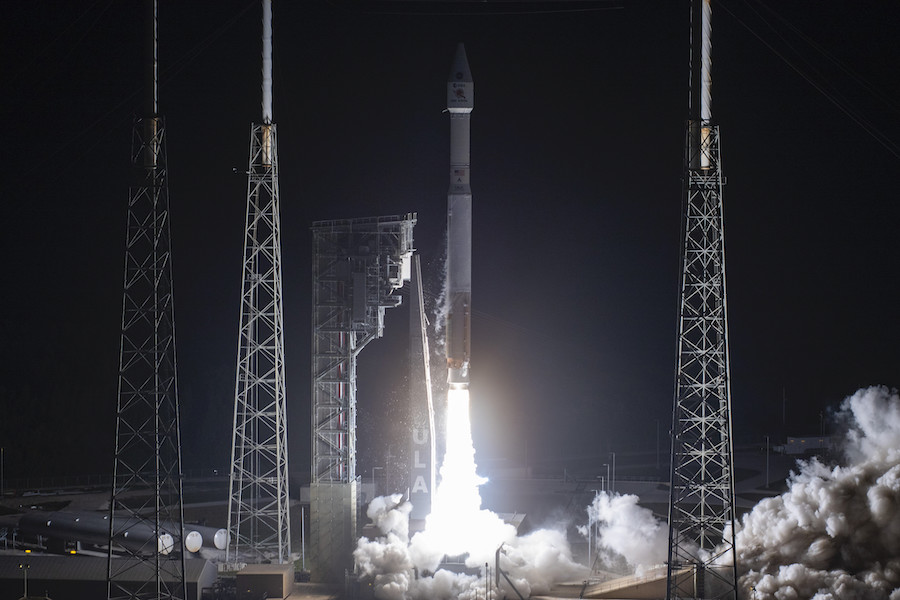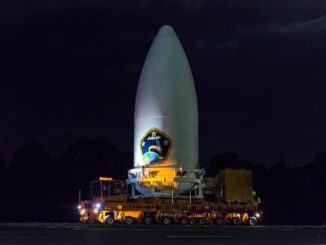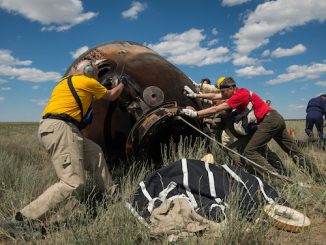STORY WRITTEN FOR CBS NEWS & USED WITH PERMISSION

Under a brilliant moon, a United Launch Alliance Atlas 5 rocket flashed to life and vaulted away from Cape Canaveral late Sunday, boosting the European Space Agency’s $1.5 billion Solar Orbiter probe out of Earth’s gravitational grip toward a multi-year voyage around the sun that will give scientists their first glimpse of the star’s poles.
The long-awaited mission marks “the first time that we send a satellite out to take images of the sun’s poles and in addition, getting the first ever data of the polar magnetic field,” said Daniel Mueller, ESA project scientist with the Solar Orbiter mission. “We believe this really holds the keys to unraveling the mysteries of the sun’s (11-year) activity cycle.
“We will also monitor the far side of the sun, which we cannot see from Earth, and combine that with data from satellites and ground-based telescopes to provide a full 3D view of our star. And so the orbiter is really a laboratory, we have a suite of 10 sophisticated instruments that we will (operate) together to track the evolution of eruptions on the sun from the surface out into space, all the way down to Earth.”
The Solar Orbiter mission comes a year and a half after NASA’s Parker Solar Probe was launched, a spacecraft that periodically flies through the sun’s super-heated outer atmosphere, or corona, enduring extreme temperatures that rule out the use of sun-facing cameras.
Instead, Parker’s instruments are focused on studying the sun’s complex electric and magnetic fields, the electrically charged particles making up the supersonic solar wind and the mechanisms that heat the corona to millions of degrees.
The Solar Orbiter will fly inside the orbit of Mercury in a highly elliptical orbit that will carry it within 26 million miles of the sun, facing temperatures hotter than a pizza oven. But that’s far enough out to enable cameras and telescopes, looking through “peepholes” in the spacecraft’s heat shield, to capture what should be spectacular views.

Along with four instruments to study the solar wind and nearby space environment, “we have six telescopes that observe the light from the sun in different parts of the rainbow spectrum,” Mueller said. “Two of those are so called coronagraphs where we block out the light of the sun itself to image the faint emission of the environment around the sun, the so called corona.
“In addition, we have these sensors that measure, for example, ions in space. Elements on the sun are not only hydrogen and helium, but also sprinkling of heavier elements like iron, oxygen, neon. We measure those at the location of the spacecraft, we really weigh the particles, but we can also measure the light that they emit on the surface and thereby we have a unique way of linking the two.”
If all goes well, the Solar Orbiter and the Parker Solar Probe will study the sun at the same time from different vantage points to help unravel some of the star’s deepest mysteries.
“It’s really a perfect dream marriage (made) in heaven,” said Guenther Hasinger, director of science for the European Space Agency.
The Solar Orbiter mission cost roughly $1.5 billion, including the Atlas 5 rocket provided by NASA. The U.S. space agency spent another $70 million building one of the spacecraft’s instruments and other components, including a sensor that NASA’s current science director, Thomas Zurbuchen, helped design.
Launch of a flagship science mission like the Solar Orbiter normally would be center stage for NASA, but thanks to a few minor processing delays, the flight ended up on the same day NASA planned to launch another mission with important, if less lofty, ambitions.
First up Sunday in a space launch double header was a Northrop Grumman Antares 230+ rocket carrying a Cygnus cargo capsule loaded with 8,000 pounds of supplies bound for the International Space Station. But that launch, from the Mid-Atlantic Regional Spaceport — MARS — on Virginia’s Eastern Shore, was called off and rescheduled for Thursday due to trouble with ground support equipment and a poor forecast early in the week.
There were no problems at the Cape Canaveral Air Force Station in Floria, and the Solar Orbiter’s Atlas 5 rocket thundered to life on time at 11:03 p.m. EST and climbed away to the east atop 1.2 million pounds of thrust and a brilliant jet of exaust.
The rocket’s Centaur upper stage was expected to release the spacecraft on an Earth-escape trajectory that eventually will carry the spacecraft within the orbit of Mercury.
To get there, Solar Orbiter will fly past Venus in late December, using the planet’s gravity to adjust its trajectory. After a second Venus flyby in August 2021, the spacecraft will whip past Earth the following November, setting up the third of eight planned Venus flybys through September 2030. Science observations will begin next year.
The gravity-assist flybys will slowly raise the tilt of the probe’s elliptical orbit with respect to the sun’s equator by about 35 degrees, allowing the spacecraft to “see” the star’s polar regions. The first “polar pass” is expected in March 2025 when the Solar Orbiter reaches an inclination of 17 degrees.

“Solar Orbiter is special because it’s really the first mission to try to link the sun to the heliosphere and establish a cause-and-effect relationship between what happens on the sun and what we observe in the near-Earth environment,” Mueller said. “In particular, we want to find out in detail about how the solar magnetic field works.
“The only way to find out is to really fly to an altitude above the sun where we can look down on the sun’s poles. And that’s what we will do for the first time.”
Zurbuchen said in an interview that studying the sun’s polar regions and learning more about the fundamental physics of the “magnetic engine of the sun, the so-called dynamo,” will lead to improved space weather forecasts and possibly even early warning of potentially destructive solar flares and coronal mass ejections that can play havoc with power grids, communications and navigation.
“It’s like your hurricane season,” he said. “There’s going to be a forecast sometime this year that says this hurricane season it’s going to be nominal, super strong and so forth. So that comes from observations of ocean temperature, from flows and so forth. We think the ingredients of the solar cycle are in the polar regions. We think if we understood that, we could predict that on a macroscopic level.”
Bottom line: “We would expect that in 10 years we have a substantially better understanding of how to predict, to model space weather, to look at the signs, the signature of the solar surface in a way that we can use it to improve models.”



